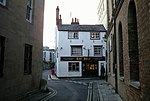King Edward Street

King Edward Street is a street running between the High Street to the north and Oriel Square to the south in central Oxford, England.To the east is the "Island" site of Oriel College, one of the colleges of Oxford University. To the west are shops, including Shepherd & Woodward, the leading University outfitters, fronting onto the High Street. King Edward Street is officially designated as part of the A420 road due to the blockage of the High Street to normal traffic. The street was only created in 1872–73 by Oriel College when 109 and 110 High Street were demolished, so it is much wider than other older streets off the High Street. The buildings were mostly designed by Frederick Codd.On the wall of the first floor of No. 6, there is a large metal plaque with a portrait of Cecil Rhodes; underneath is the inscription: In this house, the Rt. Hon Cecil John Rhodes kept academical residence in the year 1881. This memorial is erected by Alfred Mosely in recognition of the great services rendered by Cecil Rhodes to his country. On No. 14 lived Felix Yusupov, one of the murderers of Grigori Rasputin.
Excerpt from the Wikipedia article King Edward Street (License: CC BY-SA 3.0, Authors, Images).King Edward Street
Magpie Lane, Oxford City Centre
Geographical coordinates (GPS) Address Nearby Places Show on map
Geographical coordinates (GPS)
| Latitude | Longitude |
|---|---|
| N 51.752 ° | E -1.2545 ° |
Address
Oriel College
Magpie Lane
OX1 4ES Oxford, City Centre
England, United Kingdom
Open on Google Maps








